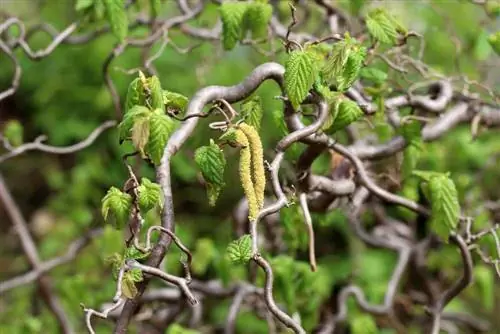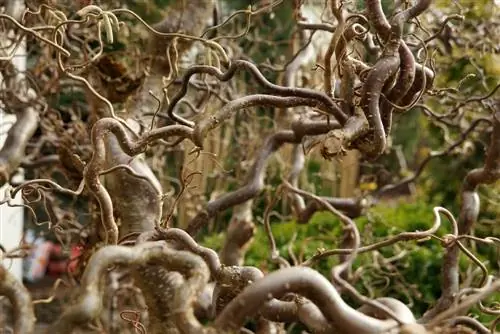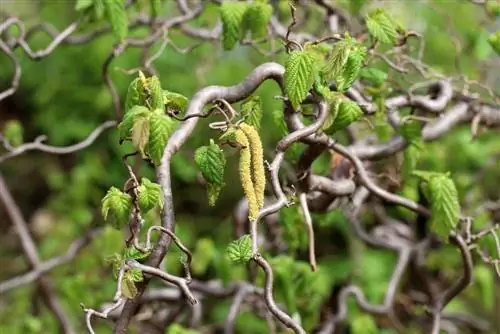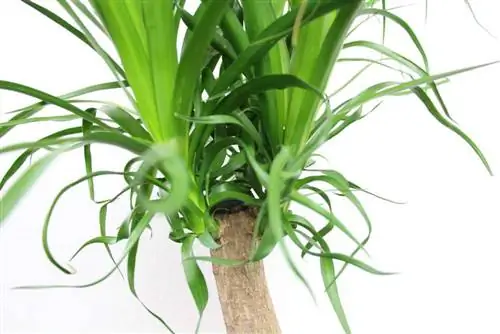- Author admin [email protected].
- Public 2023-12-17 03:39.
- Last modified 2025-01-24 12:45.
The corkscrew hazel is generally very undemanding and does not necessarily require cutting. However, if you only have limited space available, you should use scissors every now and then. The plant grows relatively quickly, up to 50 centimeters per year, and can therefore cause a real lack of space. But pruning not only prevents the plant from getting out of hand, but also promotes its vitality.
Why should the corkscrew hazel be cut?
Ideally, the corkscrew hazelnut grows into a compact, densely leafed bush. However, to ensure that the corkscrew hazel always maintains its attractive shape, it is necessary to cut it every now and then. Otherwise, the shoots will grow unhindered in all directions and thus deform the bush. Apart from that, there is a risk that the corkscrew hazel can no longer be flooded with sunlight and it will become bald from the inside.
When to cut back?
The corkscrew hazelnut can cope with pruning all year round. However, there is also an optimal time for this, because ideally the plant is cut in the vegetation-free phase between October and March. Because during this time the plant is dry and leafless. This in turn makes cutting easier because the view of the inside of the plant is not obstructed. Within this time window, the date for pruning should also meet the following requirements:
- definitely frost-free day
- best covered and not too sunny
- too much sunlight can dry out cut surfaces too much
Tip:
If the corkscrew hazel is not cut regularly, bare branches and twigs should still be cut out promptly.
Cutting back corkscrew hazel
When it comes to cutting, the corkscrew hazel is extremely forgiving. Because it can cope with both minor shortening and radical cutting. However, the latter is usually only necessary for older plants, as they tend to become bald as they age. However, it is always important to use sharp cutting tools. Otherwise the shoots could be unnecessarily injured by bruising. When cutting, make sure that the cut surfaces are as angled as possible. The following shoots should be shortened or removed:
- remove fresh shoots from the trunk
- shorten shoots that are too long by up to 2/3
- cut out at least one of crossing shoots
- cutting diseased and dead wood at the base
- cut branches growing inwards
- cut off steeply upward branches
Note:
How short the corkscrew hazel is ultimately cut is up to the hobby gardener's preferences.
Remove wildlings
Anyone who has acquired their corkscrew hazelnut as a refined tree will most likely have to deal with so-called “wildlings”. These are shoots that sprout from the base and grow dead straight. These unwanted shoots strive to overgrow the crown and impress with their enormous growth power. So that the wildlings don't get out of hand, it should always be removed. Please note the following:
- Wildlings can be removed all year round
- As soon as one is recognizable, remove it immediately
- don't cut, tear off
Note:
When wildlings are cut off, a small amount of tissue may remain. However, this is already sufficient for the wildling to continue its undiminished growth.
Rejuvenate corkscrew hazel properly

If the corkscrew hazel is already a few years old, it can be beneficial if it undergoes rejuvenation pruning. First and foremost, the plant regains vitality through rejuvenation. In the case of the corkscrew hazel, the branches twist more prominently. The lower the woodiness, the more pronounced the twisting of the branches. Rejuvenation pruning is best done between autumn and early spring. The best way to rejuvenate the corkscrew hazel is as follows:
- Spread rejuvenation cut over 3 years
- shorten 2 to 4 of the strongest and/or oldest branches every year
- cut back to about 15 cm
- After 3 years whole plant should be rejuvenated
Cutting tips
With every cut, no matter how small, it must be taken into account that the plant will be injured. Because every cut surface is also an open wound. On top of that, it makes it easier for bacteria and pests to penetrate through cut surfaces. In order to prevent any risks of illness, the following factors should be taken into account:
- Always work with a sharp cutting tool
- this must be clean
- Do not lay out the cutting surfaces horizontally
- otherwise rainwater can “stand” on it
- Keep cutting surfaces as small as possible
- the smaller, the better the healing
Note:
The corkscrew hazel can basically “heal” itself, which is why the use of wound closure agents is not necessary.






